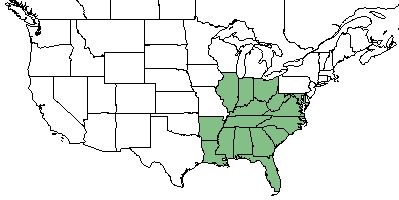Difference between revisions of "Hypericum virgatum"
Emmazeitler (talk | contribs) (→Conservation and Management) |
Emmazeitler (talk | contribs) |
||
| Line 32: | Line 32: | ||
==Ecology== | ==Ecology== | ||
===Habitat=== <!--Natural communities, human disturbed habitats, topography, hydrology, soils, light, fire regime requirements for removal of competition, etc.--> | ===Habitat=== <!--Natural communities, human disturbed habitats, topography, hydrology, soils, light, fire regime requirements for removal of competition, etc.--> | ||
| − | ''H. virgatum'' is found in hardpan woodlands, rock outcrops, woodland borders, glades and barrens (especially over mafic or ultramafic rocks).<ref name= "Weakley 2015"> Weakley, A. S. (2015). Flora of the Southern and Mid-Atlantic States. Chapel Hill, NC, University of North Carolina Herbarium. </ref> It is also generally found in fields, open woods, and various dry roadsides.<ref name= "nature"/> Specimens have been collected from loamy sand of longleaf | + | ''H. virgatum'' is found in hardpan woodlands, rock outcrops, woodland borders, glades, and barrens (especially over mafic or ultramafic rocks).<ref name= "Weakley 2015"> Weakley, A. S. (2015). Flora of the Southern and Mid-Atlantic States. Chapel Hill, NC, University of North Carolina Herbarium. </ref> It is also generally found in fields, open woods, and various dry roadsides.<ref name= "nature"/> Specimens have been collected from the loamy sand of longleaf pinelands, pond shores, moist marl-like soil in full sun, and damp meadows.<ref name = "FSU herbarium"> URL: http://herbarium.bio.fsu.edu. Last accessed: June 2018. Collectors: Debbie Milonski, R.K. Godfrey, Gary Knight, Leon Neel, David Webb, R. Komarek, J.B. Nelson, Albert B. Pittman. States and counties: South Carolina (Clarendon) Georgia (Thomas, Baker, Turner, Grady) Kentucky (Calloway) Florida (Santa Rosa, jackson, Escambia, Walton)</ref> |
===Phenology=== <!--Timing off flowering, fruiting, seed dispersal, and environmental triggers. Cite PanFlora website if appropriate: http://www.gilnelson.com/PanFlora/ --> | ===Phenology=== <!--Timing off flowering, fruiting, seed dispersal, and environmental triggers. Cite PanFlora website if appropriate: http://www.gilnelson.com/PanFlora/ --> | ||
Revision as of 20:10, 16 September 2020
Common name: Sharpleaf St. John's-wort[1], Strict St. John's-wort[2]
| Hypericum virgatum | |
|---|---|
Error creating thumbnail: Unable to save thumbnail to destination
| |
| Photo by Gary Fleming at the Digital Atlas of the Virginia Flora | |
| Scientific classification | |
| Kingdom: | Plantae |
| Division: | Magnoliophyta - Flowering plants |
| Class: | Magnoliopsida - Dicots |
| Order: | Theales |
| Family: | Clusiaceae |
| Genus: | Hypericum |
| Species: | H. virgatum |
| Binomial name | |
| Hypericum virgatum Lam. | |

| |
| Natural range of Hypericum virgatum from USDA NRCS Plants Database. | |
Contents
Taxonomic Notes
Synonyms: Hypericum acutifolium Elliott; H. denticulatum Walter; H. denticulatum Walter var. acutifolium (Elliott) Blake; H. denticulatum Walter var. recognitum Fernald & Schubert; H. denticulatum Walter ssp. acutifolium (Elliott) N. Robson.[2]
Varieties: none.[2]
Description
H. virgatum is a perennial forb/herb of the Clusiaceae family native to North America.[1]
Distribution
H. virgatum is found in the southeastern corner of the United States from Arkansas and Louisiana to Virginia and Maryland, as well as in Illinois, Indiana, and Ohio.[1]
Ecology
Habitat
H. virgatum is found in hardpan woodlands, rock outcrops, woodland borders, glades, and barrens (especially over mafic or ultramafic rocks).[3] It is also generally found in fields, open woods, and various dry roadsides.[4] Specimens have been collected from the loamy sand of longleaf pinelands, pond shores, moist marl-like soil in full sun, and damp meadows.[5]
Phenology
This species generally flowers from late June until September.[3]
Conservation and Management
Due to taxonomic discussion, this species distribution is not fully known and is therefore listed as G4 on the global status scale. It is also considered vulnerable in Virginia, critically imperiled in West Virginia, and possibly extirpated in Maryland.[4]
Cultivation and restoration
Photo Gallery
References and notes
- ↑ 1.0 1.1 1.2 USDA Plant Database https://plants.usda.gov/core/profile?symbol=HYVI6
- ↑ 2.0 2.1 2.2 Weakley, A.S. 2015. Flora of the southern and mid-atlantic states. Working Draft of 21 May 2015. University of North Carolina at Chapel Hill, Chapel Hill, North Carolina.
- ↑ 3.0 3.1 Weakley, A. S. (2015). Flora of the Southern and Mid-Atlantic States. Chapel Hill, NC, University of North Carolina Herbarium.
- ↑ 4.0 4.1 [[1]] NatureServe Explorer. Accessed: May 30, 2019
- ↑ URL: http://herbarium.bio.fsu.edu. Last accessed: June 2018. Collectors: Debbie Milonski, R.K. Godfrey, Gary Knight, Leon Neel, David Webb, R. Komarek, J.B. Nelson, Albert B. Pittman. States and counties: South Carolina (Clarendon) Georgia (Thomas, Baker, Turner, Grady) Kentucky (Calloway) Florida (Santa Rosa, jackson, Escambia, Walton)